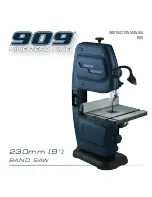
7
English
Register Online
Thank you for your purchase. Register your product now for:
•
WARRAnTY sERViCE:
Registering your product will
help you obtain more efficient warranty service in case
there is a problem with your product.
•
COnFiRMATiOn OF OWnERshiP:
In case of an
insurance loss, such as fire, flood or theft, your registration
of ownership will serve as your proof of purchase.
Repairs
WARNING:
To assure product SAFETY and RELIABILITY,
repairs, maintenance and adjustment (including power
cord repairs, and brush inspection and replacement,
when applicable) should be performed by a
D
e
WALT
factory service center or a
D
e
WALT
authorized service
center. Always use identical replacement parts.
Accessories
WARNING:
Since accessories, other than those offered
by
D
e
WALT
, have not been tested with this product,
use of such accessories with this product could be
hazardous. To reduce the risk of injury, only
D
e
WALT
recommended accessories should be used with
this product.
Recommended accessories for use with your product are
available at extra cost from your local dealer or authorized
service center. If you need assistance in locating any
accessory, please contact
D
e
WALT
call 1‑800‑4‑
D
e
WALT
(
1‑800‑433‑9258
) or visit our website:
www.dewalt.com
.
Cleaning
WARNING:
Blow dirt and dust out of all air vents with
clean, dry air at least once a week. To minimize the risk
of eye injury, always wear ANSI Z87.1 approved eye
protection when performing this procedure.
WARNING:
Never use solvents or other harsh
chemicals for cleaning the non‑metallic parts of the
tool. These chemicals may weaken the plastic materials
used in these parts. Use a cloth dampened only with
water and mild soap. Never let any liquid get inside the
tool; never immerse any part of the tool into a liquid.
MAINTENANCE
WARNING: To reduce the risk of serious personal
injury, turn unit off and disconnect it from
power source before making any adjustments or
removing/installing attachments or accessories.
An accidental start‑up can cause injury.
Your
D
e
WALT
power tool has been designed to operate
over a long period of time with a minimum of maintenance.
Continuous satisfactory operation depends upon proper tool
care and regular cleaning.
5. Blade will begin to feed into material. Always be sure
blade is completely through material before continuing
with pocket cut.
nOTE:
In areas where blade visibilty is limited, use the edge
of the saw shoe as a guide. Lines for any given cut should be
extended beyond edge of cut to be made.
Cutting
CAUTION:
When sawing into walls, floors or wherever
“live” electrical wires may be encountered, DO NOT
TOUCH ANY FRONT METAL PARTS OF THE TOOL! Hold
the tool only by the plastic handle and housing to
prevent electric shock if you saw into a “live” wire.
CAUTION:
Always wear eye protection while operating
this power tool.
Cutting with Blade in Horizontal Position
(Fig. A, C)
Installing a blade in the horizontal orientation allows cutting
close to floors, walls or ceilings where limited clearance is
available. Ensure that the blade guard
4
is pressed against
the framing to avoid kickback.
Flush‑To Cutting (Fig. D)
The compact design of the saw motor housing and spindle
housing permits extremely close cutting to floors, corners
and other difficult areas.
Wood Cutting (Fig. E)
1. Before cutting any type of wood, be sure it is firmly
anchored or clamped to prevent slipping.
2. Place blade lightly against work to be cut, switch on saw
motor and allow it to obtain maximum speed before
applying pressure.
3. Always hold saw firmly with both hands while cutting.
Whenever possible, the saw shoe
6
must be held firmly
against the material being cut. This will prevent the saw
from jumping or vibrating and minimize blade breakage.
Metal Cutting (Fig. F)
This unit has different metal cutting capacities depending
upon type of blade used and the metal to be cut.
Use a finer blade for ferrous metals and a coarse blade for
non‑ferrous materials. In thin gauge sheet metals it is best
to clamp wood to both sides of sheet. This will insure a clean
cut without excess vibration or tearing of metal. Always
remember not to force cutting blade as this reduces blade
life and causes costly blade breakage.
nOTE:
It is generally recommended that when cutting
metals you should spread a thin film of oil or other coolant
along the line ahead of the saw cut for easier operation and
longer blade life.
Pocket Cutting ‑ Wood Only (Fig. G)
The initial step in pocket cutting is to measure the surface
area to be cut and mark clearly with a pencil, chalk or scriber.
1. Insert pocket cutting blade in blade clamp and tighten
blade clamp securely.
2. Next, tip the saw backward until the back edge of the
shoe is resting on the work surface.
3. Now switch motor on, always permitting blade to attain
maximum speed.
4. Grip handle steadily and begin a slow, deliberate upward
swing with the handle of the saw.










































